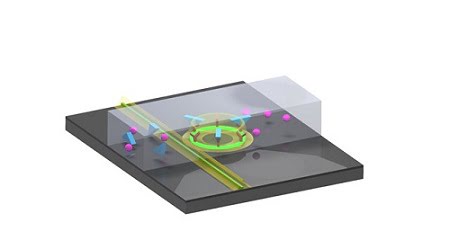(Nano-Plasmonic) Structure, structure and properties of Nano Sensor Plasmonic
Researcher and author: Dr. ( Afshin Rashid)
Note: The structure of plasmonic nanosensors using nanoelectronics technology has been significantly improved so far. In such a way that more accurate, smaller and highly sensitive sensors have been obtained under the name of plasmonic smart nanosensors.
Electronic-Plasmonic Sensors In fact, the range of motion of these sensors is in nanometer dimensions. For this reason, they have a very high accuracy and reactivity. Various sciences such as biochemistry, biology, electronics, various branches of chemistry and physics are involved in the design of a plasmonic nano sensor. The main part of a chemical or biological sensor is its nano-sensor element. The nano-sensor element is in contact with a detector. This element is responsible for identifying and linking to the species in a complex specimen. The detector then converts the chemical signals generated by the nanosensor element coupled to the target species into a measurable output signal. Biosensors rely on biological components such as antibodies. Enzymes, receptors, or whole cells can be used as sensors.
Structure and properties (plasmonic nano sensors)
The need to build more accurate, smaller, and more capable sensors was felt. Today, high-sensitivity sensors are used that are sensitive to small amounts of gas, heat, or radiation. Increasing the sensitivity, efficiency and accuracy of these sensors requires the discovery of new materials and tools. Plasmonic nanosensors are nanometer-sized sensors that, due to their small size and nanometer size, have a very high accuracy and reactivity, so that they even react to the presence of several atoms of a gas.
Nanosensors are classified into different types. One of these categories is based on the shape of nanoparticles and their application as follows:
A. Nanostructures: Like porous silicon, nanosensors made from these materials are used to detect chemical and biological reactions.
B- Nanoparticles: such as nanoscale spherical materials that are used as optical-biological, optical-chemical receptors and space image sensors
have. Like nanosilicon particles that are used as biosensors. Nanosensors can also be divided into three categories based on their structure: quantum dots, carbon nanotubes, and nanomaterials.
Properties of nanosensors:
An ideal sensor should have the following characteristics:
1. The output signal should be proportional to the type and amount of the target species.
2. Act very specific to the species.
3. Have high resolution and selectivity.
4. Have high repeatability and accuracy.
5. Have a high response speed (in milliseconds)
6. Failure to respond to environmental disturbances such as temperature, ionic strength of the environment and .....
Conclusion :
The structure of plasmonic nanosensors using nanoelectronic technology has been significantly improved so far. In such a way that more accurate, smaller and highly sensitive sensors have been obtained under the name of plasmonic smart nanosensors.
Researcher and author: Dr. ( Afshin Rashid)
PhD in Nano-Microelectronics




